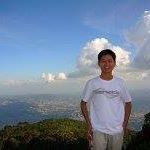Chao Sheng Yang
age ~54
from Irvine, CA
- Also known as:
-
- Chao S Yang
- Chao Shu Yang
- Chad S Yang
- Chien S Yang
- Chao-Shu Yang
- Sheng Yang Chao
- Victoria Brown
- Phone and address:
-
185 Cantata, Irvine, CA 92606
(949)2505957
Chao Yang Phones & Addresses
- 185 Cantata, Irvine, CA 92606 • (949)2505957
- 6 Topeka, Irvine, CA 92604 • (949)6536838
- 2814 Glen Dixon Ct, San Jose, CA 95148 • (408)2709264
- 185 Estancia Dr #239, San Jose, CA 95134 • (408)2709264
- 49070 Woodgrove Cmn, Fremont, CA 94539 • (510)3539264
- Alameda, CA
- Los Angeles, CA
Us Patents
-
Digital Visual And Sensor Simulation System For Generating Realistic Scenes
view source -
US Patent:53176898, May 31, 1994
-
Filed:Aug 10, 1990
-
Appl. No.:7/565864
-
Inventors:Myron L. Nack - Los Alamitos CA
Thomas O. Ellis - Playa Del Rey CA
Norton L. Moise - Pacific Palisades CA
Andrew Rosman - Los Alamitos CA
Robert J. McMillen - Long Beach CA
Chao Yang - Cerritos CA
Gary N. Landis - Hermosa Beach CA -
Assignee:Hughes Aircraft Company - Los Angeles CA
-
International Classification:G06F 1516
G06F 1566 -
US Classification:395163
-
Abstract:A system using a ray-tracing algorithm and a hierarchy of volume elements (called voxels) to process only the visible surfaces in a field of view. In this arrangement, a dense, three-dimensional voxel data base is developed from the objects, their shadows and other features recorded, for example, in two-dimensional aerial photography. The rays are grouped into subimages and the subimages are executed as parallel tasks on a multiple instruction stream and multiple data stream computer (MIMD). The use of a three-dimensional voxel data base formed by combining three-dimensional digital terrain elevation data with two-dimensional plan view and oblique view aerial photography permits the development of a realistic and cost-effective data base. Hidden surfaces are not processed. By processing only visible surfaces, displays can now be produced depicting the nap-of-the-earth as seen in low flight of aircraft or as viewed from ground vehicles.
-
Method For Managing Namespaces In A Storage Device And Storage Device Employing The Same
view source -
US Patent:20220269427, Aug 25, 2022
-
Filed:Feb 25, 2022
-
Appl. No.:17/681216
-
Inventors:- Suwon-si, KR
Chao Yang - San Jose CA, US -
International Classification:G06F 3/06
-
Abstract:A provided a storage device configured to support a number of namespaces. The storage device includes a memory and a controller coupled to the memory. The controller includes a host interface layer and a flash translation layer configured to report to the host interface layer a first over-provisioning chunk from an over-provisioning pool and a first chunk separate from the over-provisioning pool. The controller is configured to receive a command at the host interface layer to utilize a portion of the memory for a first namespace from among the number of namespaces and the first namespace includes an unaligned chunk. The controller is configured to utilize the first over-provisioning chunk as the unaligned chunk of the first namespace. A number of over-provisioning chunks to be utilized as unaligned chunks is less than the number of namespaces.
-
Image Hole Filling That Accounts For Global Structure And Local Texture
view source -
US Patent:20180165798, Jun 14, 2018
-
Filed:Dec 14, 2016
-
Appl. No.:15/379337
-
Inventors:- San Jose CA, US
Xin LU - Mountain View CA, US
Chao YANG - Los Angeles CA, US -
International Classification:G06T 5/00
G06K 9/46
G06T 7/40
G06K 9/62
G06K 9/66 -
Abstract:Image hole filling that account for global structure and local texture. One exemplary technique involves using both a content neural network and a texture neural network. The content neural network is trained to encode image features based on non-hole image portions and decode the image features to fill holes. The texture neural network is trained to extract image patch features that represent texture. The exemplary technique receives an input image that has a hole and uses the two neural networks to fill the hole and provide a result image. This is accomplished by selecting pixel values for the hole based on a content constraint that uses the content neural network to account for global structure and a texture constraint that uses the texture neural network to account for local texture. For example, the pixel values can be selected by optimizing a loss function that implements the constraints.
Name / Title
Company / Classification
Phones & Addresses
President
OriginLab Corporation
Computer Software Publishers & Developers. Computers Software & Services
Computer Software Publishers & Developers. Computers Software & Services
1 Roundhouse Plaza, Suite 303, Northampton, MA 01060-4408
(413)5862013, (413)5850126
(413)5862013, (413)5850126
President
Sysp, Inc
2882 Walnut Ave, Tustin, CA 92780
President
V5 Transportation, Inc
Transportation Services · Transportation Services Local Trucking-With Storage General Warehouse/Storage · Transportation Services, Nec, Nsk
Transportation Services · Transportation Services Local Trucking-With Storage General Warehouse/Storage · Transportation Services, Nec, Nsk
10507 Vly Blvd, El Monte, CA 91731
825 Ajax Ave, Whittier, CA 91748
825 Ajax Ave, Whittier, CA 91748
President
JERRYSON MEDIA CORP
3839 Michillinda Dr, Pasadena, CA 91107
470 Carbonia Ave, Walnut, CA 91789
470 Carbonia Ave, Walnut, CA 91789
CHAO HUA YANG INC
PACIFIC INSTITUTE OF PROPERTY DEVELOPMENT, LLC
ASIAN EXPRESS YANG LI INC
PACIFIC INSTITUTE OF PROPERTY MANAGEMENT LLC
Isbn (Books And Publications)

License Records
Chao Yang
License #:
NA04796 - Expired
Category:
Nursing Assistant
Issued Date:
Dec 19, 1990
Expiration Date:
Jun 30, 1998
Type:
Nursing Assistant
Resumes

Chao Yang Irvine, CA
view sourceWork:
UC Irvine
Irvine, CA
Jun 2013 to Oct 2013
Graduate Research Assistant HK Baptist University
HK, HK
2011 to 2012
Student Research Assistant
Irvine, CA
Jun 2013 to Oct 2013
Graduate Research Assistant HK Baptist University
HK, HK
2011 to 2012
Student Research Assistant
Education:
University of California
Irvine, CA
2012 to 2014
MS in Electrical Engineering and Computer Science Hong Kong Baptist University
2008 to 2012
BS in Applied Physics
Irvine, CA
2012 to 2014
MS in Electrical Engineering and Computer Science Hong Kong Baptist University
2008 to 2012
BS in Applied Physics
Skills:
Python, R, C/C++, MATLAB, Java, SPSS, SQL, Mathematica, Linux, Emacs, HTML, CSS

Chao Yang
view source
Chao X. Yang
view source
Chao Yang
view source
Chao Fan Yang
view source
Chao Lis Yang
view source
Chao Yang
view source
Chao Yang
view source
Chao Yang
view sourcePlaxo

Chao Yang
view source
yang chao jiun
view sourceCMC
Classmates

Chao Yang
view sourceSchools:
Euless Junior High School Euless TX 1992-1995
Community:
Gwen Sellers

Apalachee High School, Wi...
view sourceGraduates:
Jessica Bolger (2001-2005),
Chao Yang (2000-2002),
Andrew Sanderson (2005-2009),
Amanda Crabtree (2002-2006),
Christopher Plybon (2001-2005)
Chao Yang (2000-2002),
Andrew Sanderson (2005-2009),
Amanda Crabtree (2002-2006),
Christopher Plybon (2001-2005)

Euless Junior High School...
view sourceGraduates:
Becki Jetton (1970-1972),
Richard Lemmon (1970-1974),
Liena Abdelwahab (2000-2004),
Sidney Denbina (1987-1991),
Chao Yang (1992-1995)
Richard Lemmon (1970-1974),
Liena Abdelwahab (2000-2004),
Sidney Denbina (1987-1991),
Chao Yang (1992-1995)
Flickr
Googleplus

Chao Yang
Education:
Hmong College Prep Academy - High school, Huson Middle School - 8th grade, Baldwin-woodvile school district - Elementry and middle school
Relationship:
In_a_relationship

Chao Yang
Education:
Towson University - Biology

Chao Yang
Education:
DePaul University - Computational Finance

Chao Yang
Education:
University of Leicester

Chao Yang
Education:
The Univeristy of Minnesota

Chao Yang
Education:
Carnegie Mellon University

Chao Yang

Chao Yang
About:
Ich bin beatmaker
Tagline:
Der Gründer "D.I.G. Beatz"
Youtube
Myspace
Get Report for Chao Sheng Yang from Irvine, CA, age ~54

























